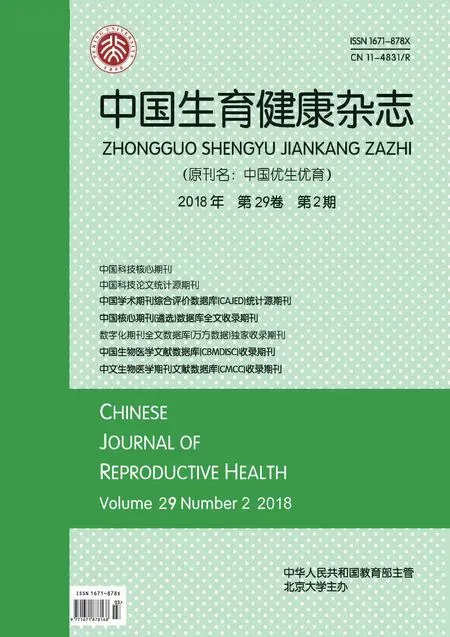卵胞浆内单精子注射的精子优选
汪彩珠 冯贵雪
辅助生殖技术(assisted reproductive technology,ART)助孕成功的关键是获得有活力的胚胎。而胚胎的发育受卵子和精子质量的影响。在早期胚胎的前2次分裂主要受母源基因调控,而当胚胎发育到4~8细胞后,胚胎基因组激活,父源基因组开始发挥作用,异常的精子可能降低后期胚胎发育潜能,从而影响临床结局[1-2]。因此理论上,提高用于授精的精子质量能提高ART助孕结局。
体外受精(in vitro fertilization,IVF)中的常规精子优选方法仅限于精液洗涤中的密度梯度离心法和上游法。卵胞浆内单精子注射(intracytoplasmic sperm injection,ICSI)中常规的精子优选方法是基于精子活力和200倍或400倍镜下精子大致形态进行的选择。然而,这些方法不能有效筛选出DNA完整的精子,事实上,形态正常的精子中DNA碎片仍然较高[3]。因此,从提高ART有效性和安全性角度出发,迫切需要新的精子优选技术。为此,本文对国内外报道的关于ICSI精子优选的新方法进行综述分析。
一、精子膜表面电荷的选择
成熟精子膜携带负电荷,基于这种表面电荷差异的精子优选方法有微流小室电泳法和电动电位法。Ainsworth等[4]首先提出利用微流小室电泳法能有效地分离出前向的、形态正常的、DNA损伤小的精子。最近,Luke等[5]改进了微流电泳法,有效地分离出携带负电荷的健康精子,并认为携带负电荷可作为健康精子的潜在生化标记。精子电动电位是精子膜和它周围的电位差,获能的精子电动电位更低。基于此,Chan等[6]利用电动电位法快速筛选出了形态正常、DNA完整、成熟的精子。Zahedi等[7]利用该方法也成功优选出高比例的形态正常、DNA碎片低和鱼精蛋白缺乏的精子。相比于微流小室电泳法,电动电位法操作更简单,且不需要昂贵仪器,但是该方法精子回收率低,且不适用于从睾丸或附睾中获取的精子。因此,依据精子膜表面电荷的上述两种精子优选方法,缺乏后续用于IVF或ICSI的妊娠结局的报道,也因各自的缺陷,目前尚未能在临床上广泛推广应用。
二、非凋亡精子的选择
凋亡的精子DNA发生断裂,影响胚胎的发育。因此,选择非凋亡的精子理论上能提高临床结局。ART中非凋亡精子的选择是基于在凋亡早期阶段,精子膜磷酯酰丝氨酸外显化的特征进行。常用的有磁性活化细胞分选法(magnetic-activated cell sorting,MACS)。这种方法是利用磷酯酰丝氨酸与膜联蛋白V具有高度亲和力的特征进行凋亡与非凋亡精子的选择。研究表明,利用膜联蛋白V磁珠与凋亡精子结合的特性可以有效地从冻融精液中富集非凋亡精子[8]、形态正常的精子[9],并且进一步研究表明分离柱和磁珠对于精子功能没有影响[8]。但也有研究表明MACS法富集的精子与上游法富集的精子质量类似[10]。Rawe等[11]利用MACS法对高凋亡比率的精液进行优选,然后进行ICSI,获得了良好妊娠结局。同样,Herrero等[12]报道了一例2次ICSI治疗失败的男性癌症患者,利用MACS法优选复苏的精液进行ICSI,最终双胎妊娠。这表明MACS法是一种能提高精液质量的有潜力的筛选方法。但是该方法需要与密度梯度离心法结合使用,精子回收率低,不适用于严重少弱精子,并且部分精子可能携带磁珠,存在未知的安全隐患,阻碍了该方法的临床推广应用。
三、透明质酸结合法选择
透明质酸(hyaluronic-acid,HA)是卵冠丘胞外基质的主要成分。精子质膜上透明质酸结合位点的形成是精子成熟的标志。在正常受精过程中,成熟的精子依靠头部HA结合位点与HA结合并消化HA,从而更好地穿过卵冠丘复合物与卵子结合,而不成熟精子则无法与HA结合。在体外,HA已作为成熟精子的生理选择器。目前,可直接应用的HA精子选择体系有2种。一种是商业化的生理性卵胞浆内单精子注射皿(physiological intracytoplasmic sperm injection,PICSI)即底部涂有HA的ICSI皿。另一种是含有HA的培养液(spermSlow)。两种均是在ICSI时,选择与HA粘附的精子进行显微注射。
关于HA优选精子的报道较多。研究表明经透明质酸结合试验优选出的精子,凋亡标记蛋白的比例显著减少[13],DNA碎片和核异常比例显著减少[14],染色体非单倍体的比率也显著降低[15]。但也有研究表明利用HA优选出的精子DNA完整性与常规PVP中选择的精子没有区别[16]。而临床研究则表明PICSI相比于常规ICSI,受精率、胚胎质量、种植率、妊娠率和活产率都得到显著提高,并且受精率与HA结合试验结果密切相关[17]。但也有研究表明PICSI能提高受精率,对于妊娠率和种植率没有影响[14]。HA结合法虽然能优选出成熟的精子,但也存在可能将HA带入卵母细胞中的不安全隐患。另外,最近一篇Meta分析表明目前尚没有足够证据支持在所有ICSI周期中应用HA法进行精子优选[18]。
四、精子双折射特性选择
成熟的精子细胞核由于纵向定位的顶体下的蛋白纤维丝而具有较高的内在双折射特性。使用偏振光显微镜可以进行精子双折射特性的观察,从而进行成熟精子的选择。研究表明精液中具有双折射特性精子的比率与精液浓度、活率和活力相关[19]。对无前向运动和睾丸穿刺获取的精液利用双折射特性对精子进行选择后行ICSI,虽然受精率和卵裂率没有差异,但显著提高了临床妊娠率、种植率和继续妊娠率[19]。此外,利用双折射特性可以筛选出已发生顶体反应和未发生顶体反应的精子,分别用这些精子进行ICSI,结果表明两组的受精率和胚胎质量没有区别,但是顶体反应组的胚胎种植率显著高于未反应组[20]。最近的一篇研究也表明利用精子头部的双折射特性测量的光延迟值与临床结局息息相关,临床结局最佳的精子头光延迟范围为0.56 nm~0.91 nm[21]。虽然依据双折射特性能优选出成熟的精子,但有关其应用的报道相对较少,而对于后代的安全性则未见相关报道。
五、超高倍镜下精子形态选择
细微的精子形态学差异(顶体、细胞核、线粒体、顶体后致密板和颈部)能通过超高倍显微镜(6 000×)观察到,此技术称为MSOME(motile sperm organelle morphology examination )。通过此技术可以筛选出精子核、顶体后致密板、顶体、颈部及尾部都正常的精子。卵胞浆内形态学选择单精子注射(intracytoplasmic morphologically selected sperm injection,IMSI)是MSOME方法在ICSI中的改进应用[22]。
Bartoov等[22]研究表明IMSI比常规ICSI能产生更高的妊娠率和抱孩率,但受精率、卵裂率则没有明显区别。随后,Berkovitz等[23]通过大样本研究进一步证实了IMSI能显著提高临床结局。一项前瞻性随机自身对照研究也表明[24],对于精液质量差、胚胎质量差、多次ICSI失败的患者,IMSI技术能提高胚胎质量和临床结局。尤其对于反复ICSI失败的患者,IMSI技术能显著提高临床妊娠率和活产率[25-26]。进一步研究表明IMSI技术提高临床结局的同时并没有影响到胚胎的整倍性[27]。但是,另一项随机对照研究则表明IMSI和ICSI技术对于患者临床妊娠率和活产率无显著区别[28]。另外,由于IMSI技术操作时间长且精子长时间处在PVP中,可能会损伤精子。因为PVP能引起精子膜的损伤和诱导顶体反应[29]。此外,高倍镜下光源对配子的潜在影响尚未可知,也存在一定的安全隐患。因此,Meta分析关于IMSI的随机对照研究结果表明目前尚没有证据支持临床应用IMSI[30]。
综上所述,目前报道的这些精子优选方法在一定程度上能提高精子质量,但是这些优选方法目前仍然缺乏大量的前瞻性的随机对照研究,缺乏可应用于所有ICSI患者的证据支持。另外,这些方法操作复杂、费时、昂贵及潜在的安全隐患阻碍了其进一步的推广应用。因此,建立安全、方便、快捷的精子优选方法依然是生殖学家们研究的热点。
1 Tesarik J.Paternal effects on cell division in the human preimplantation embryo.Reprod Biomed Online,2005,10:370-375.
2 Garcia-Ferreyra J,Luna D,Villegas L,et al.High aneuploidy rates observed in embryos derived from donated oocytes are related to male aging and high percentages of sperm DNA fragmentation.Clin Med Insights Reprod Health,2015,9:21-27.
3 Avendano C,Oehninger S.DNA fragmentation in morphologically normal spermatozoa:how much should we be concerned in the ICSI era? J Androl,2011,32:356-363.
4 Ainsworth C,Nixon B,Aitken R.Development of a novel electrophoretic system for the isolation of human spermatozoa.Hum Reprod,2005,20:226-270.
5 Luke S,Kristin M,Kenneth I,et al.Optimization of microelectrophoresis to select highly negatively charged sperm.J Assist Reprod Genet,2016,33:679-688.
6 Chan PJ,Jacobson JD,Corselli JU,et al.A simple zeta method for sperm selection based on membrane charge.Fertil Steril,2006,85:481-486.
7 Zahedi A,Tavalaee M,Deemeh MR,et al.Zeta potential VS apoptotic marker:which is more suitable for ICSI sperm selection? J Assist Reprod Genet,2013,30:1181-1186.
8 Paasch U,Grunewald S,Wuendrich K,et al.Immunomagnetic removal of cryo-damaged human spermatozoa.Asian J Androl,2005,7:61-69.
9 Hoogendijk CF,Kruger TF,Bouic PJ,et al.A novel approach for the selection of human sperm using annexin V-bingding and flow cytometry.Fertil Steril,2009,91:1285-1292.
10 Curti G,Skowronek F,Vernochi R,et al.Morphological evaluation of sperm from infertile men selected by magnetic activated cell sorting(MACS).Reprod Biol,2014,14:289-292.
11 Rawe VY,Boudri HU,Alvarez Sedó C,et al.Healthy baby born after reduction of sperm DNA fragmentation using cell sorting before ICSI.Reprod Biomed Online,2010,20:320-323.
12 Herrero MB,Delbes G,Chunq JT,et al.Case report:the use of annexin V coupled with magnetic activated cell sorting in cryopreserved spermatozoa from a male cancer survivor:healthy twin newborns after two previous ICSI failure.J Assist Reprod Genet,2013,30:1415-1419.
13 Sakkas D.Novel technologies for selecting the best sperm for in vitro fertilization and intracytoplasmic sperm injection.Fertil Steril,2013,99:1023-1029.
14 Parmegiai L,Coqniqni GE,Bernardi S,et al.Physiologic ICSI:hyaluronic acid(HA)favors selection of spermatozoa without DNA fragmentation and with normal nucleus,resulting in improvement of embryo quality.Fertil Steril,2010,93:598-604.
15 Huszar G,Jakab A,Sakkas D,et al.Fertility testing and ICSI sperm selection by hyaluronic acid binding:clinical and genetic aspect.Reprod Biomed Online,2007,14:650-663.
16 Huang MT,Kuo-Kuang L R,Lu CH,et al.The efficiency of conventional microscopic selection is comparable to the hyaluronic acid binding method in selecting spermatozoa for male infertility patients.Taiwan J Obstet Gynecol,2015,54:48-53.
17 Mokánszki A,Tóthné EV,Bodnár B,et al.Is sperm hyaluronic acid binding ability predictive for clinical success of intracytoplasmic sperm injection:PICSI vs.ICSI? Syst Biol Reprod Med,2014,60:348-354.
18 Beck-Fruchter R,Shalev E,Weiss A.Clinical benefit using sperm hyaluronic acid binding technique in ICSI cycles:a systematic review and meta-analysis.Reprod Biomed Online,2016,32:286-298.
19 Gianaroli L,Magli C,Cooldel G,et al.Sperm head’s birefringence:a new criterion for sperm selection.Fertil Steril,2008,90:104-112.
20 Gianaroli L,Magli MC,Ferraretti AP,et al.Birefringence characteristics in sperm heads allow for the selection of reacted spermatozoa for intracytoplasmic sperm injection.Fertil Steril,2010,93:807-813.
21 Vermev BG,Chapman MG,Cooke S,et al.The relationship between sperm head retardance using polarized light microscopy and clinical outcome.Reprod Biomed Online,2015,30:67-73.
22 Bartoov B,Berkovitz A,Eltes F,et al.Pregnancy rates are higher with intracytoplasmic morphologically selected sperm injection than with conventional intracytoplasmic injection.Fertil Steril,2003,80:1413-1419.
23 Berkovita A,EItes F,Lederman H,et al.How to improve IVF-ICSI outcome by sperm selection.Reprod Biomed Online,2006,12:634-638.
24 Knez K,Zorn B,Tomazevic T,et al.The IMSI procedure improves poor embryo developet in the same infertile couples with poor semen quality:A comparative prospective randomized study.Reprod Biol Endocrinol,2011,9:123.
25 Shalom-Paz E,Anabusi S,Michaeli M,et al.Can intracytoplasmatic morphologically selected sperm injection (IMSI)technique improve outcome in patients with repeated IVF-ICSI failure? A comparative study.Gynecol Endocrinol,2015,31:247-251.
26 Setti AS,Braga DP,Figueira RC,et al.Intracytoplasmic morphologically selected sperm injection results in improved clinical outcomes in couples with previous ICSI failures or male factor infertility:a meta-analysis.Eur J Obstet Gynecol Reprod Biol,2014,183:96-103.
27 Luna D,Hilario R,Dueas-Chacón J,et al.The IMSI procedure improves laboratory and clinical outcomes without compromising the aneuploidy rate when compared to the classical ICSI procedure.Clin Med Insights Reprod Health,2015,12:29-37.
28 La Sala GB,Nicoli A,Fornaciari E,et al.Intracytoplasmic morphologically selected sperm injection versus conventional intracytoplasmic sperm injection:a randomized controlled trial.Reprod Biol Endocrinol,2015,13:97.
29 Kato Y,Nagao Y.Effect of polyvinylpyrrolidone on sperm function and early embryonic development following intracytoplasmic sperm injection in human assisted reproduction.Reprod Med Biol,2012,11:165-176.
30 Teixeira DM,Barbosa MA,Ferriani RA,et al.Regular (ICSI) versus ultra-high magnification (IMSI) sperm selection for assisted reproduction.Cochrane Database Syst Rev,2013,25:CD010167.

